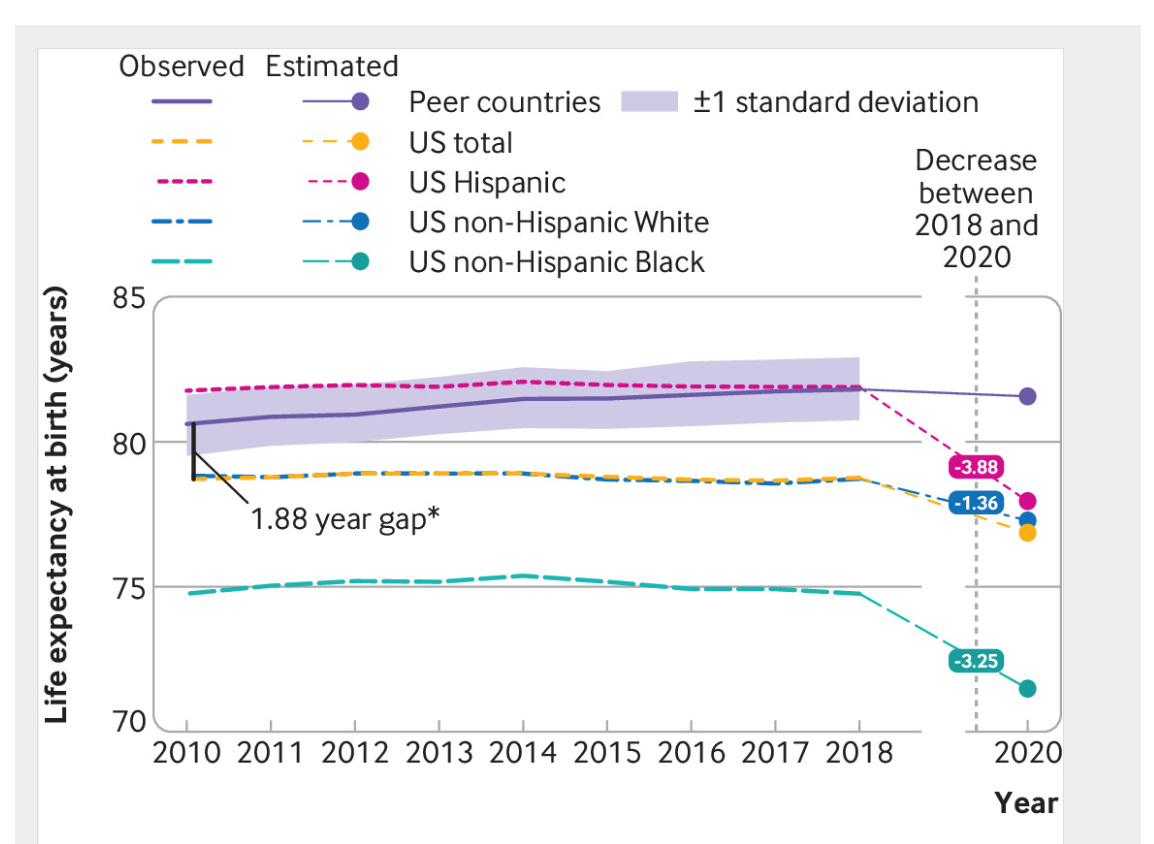In August America’s Center for Disease Control (CDC) published a set of data that ought to have brought political, economic and social debate to a standstill. If there is one question that should surely dominate public policy debate, it is the question of life and death. What did the Declaration of Independence promise, after all, if not “life, liberty and the pursuit of happiness”. But on that score the CDC in 2022 delivered alarming news. In the last three years, life expectancy in the United States has plunged in a way not seen at any point in recent history.

Source: CDC
America is inured to bad news about its health. Life expectancy in the United States has stagnated since 2011, a trend which separates the United States not just from rich peer countries but from most other countries in the world, rich or poor.
Given economic growth and advances in medicine for life expectancy to stagnate requires serious headwinds. In the United States those headwinds include, homicides and suicides, the opioid epidemic (so-called deaths of despair) car accidents and obesity. As John Burn-Murdoch shows in the FT, without those factors the US would have tracked its peer societies much more closely.

Source: FT
But stagnation is one thing, the collapse since 2019 is a phenomenon of a different quality. It is a full measure of the disaster that was the COVID pandemic in the United States. Over a million Americans died of COVID, one of the worst outcomes on the planet.
According to the CDC, half the disastrous fall in life expectancy is attributable to COVID with the opioid epidemic being a second significant factor.

Source: CDC
The data are eye-catching in their own right. But when you put them together with global figures, you find that 2021 marked the moment in which American life expectancy was overtaken by that of China. This is a historic transition in some ways even more telling than the more commonly cited GDP figures.

In living memory China’s life expectancy languished at levels prevailing in the West a hundred years ago. By the 1980s, thanks to the provision of basic sanitation, a minimum standard of living and health care, Communist China had surged ahead of most other developing countries. Chartbook Newsletter #28 showcased the reports of the World Bank on this startling fact. China’s dramatic economic growth since the 1980s propelled further steady increases.
In terms of healthy years of life, China overtook the United States already in 2018. At the time the United States was one of only five countries – the others being Somalia, Afghanistan, Georgia and Saint Vincent and the Grenadines – that were experiencing a fall in healthy life expectancy at birth. Extrapolating those trends, China was expected to overtake the United States in absolute life expectancy by the mid 2020s. The divergence in the handling of the COVID pandemic has brought that moment forward to 2021.
Zero COVID is now a strategy much criticized in the West. The cost to China in GDP terms in 2022 will be great. The megacity of Chengdu is the latest to be shutdown. As of this week, its 21 million inhabitants are confined to their homes. That will involve a nightmarish restriction of day to day freedoms. But Beijing operates under the assumption that given its current rate of vaccination, a Western-style epidemic would cost 1.5 million deaths nationwide and it is not willing to pay that price. The consequences of that painful choice show in the data. In 2020, unlike in most other countries, life expectancy in China actually increased and will likely increase again in 2021. The contrast to the United States is stark.
It is worth pausing at this point to briefly explain what “life expectancy” measures. As the BMJ explains:
Life expectancy is a widely used statistic for summarizing a population’s mortality rates at a given time.2 It reflects how long a group of people can expect to live were they to experience at each age the prevailing age specific mortality rates of that year.3 Estimates of life expectancy are sometimes misunderstood. We cannot know the future age specific mortality rates for people born or living today, but we do know the current rates. Computing life expectancy (at birth, or at ages 25 or 65) based on these rates is valuable for understanding and comparing a country’s mortality profile over time or across places at a given point in time. Estimates of life expectancy during the covid-19 pandemic, such as those reported here, can help clarify which people or places were most affected, but they do not predict how long a group of people will live. This study estimated life expectancy for 2020. Life expectancy for 2021 and subsequent years, and how quickly life expectancy will rebound, cannot be calculated until data for these years become available.
Source: BMJ
Rather than life expectancy, it might be better to refer to the measure as something akin to mortality profile.
In any case, it is not only China that has overtaken the United States based on this metric. In 2021 Cuba has a higher life expectancy than the US. So does Albania.
In a society marked by inequality as deep as modern America’s, to speak in terms of national averages is not very meaningful. The circumstances of life and health outcomes are vastly different.
COVID impacted the minority populations of the United States with particular force, and Hispanics and Hispanic men in particular. In 2020 life expectancy of Hispanics fell by almost 4 years.


Source: BMJ
Hispanics entered the pandemic with life expectancy substantially above the national average. The opposite is the case for Black Americans.
In 2021, according to the CDC, the life expectancy of Black American men at birth was 66.7 years, as compared to 73.7 for Non-Hispanic Whites.

Source: CDC
A life expectancy of 66.7 means that Black men in the United States have, at birth, the same life expectancy as men in Pakistan, a country which ranks #150 out of 193 on the global list. In 2021, a boy born in an African success story like Rwanda has a longer life expectancy than a Black boy born in the United States. Men in India, Laos and North Korea have a higher life expectancy than Black men in America.
The most disadvantaged populations of all are Native Americans. In 2021, according to the CDC, Native American men have a life expectancy that puts them on a par with low-income Sub-Saharan African countries such as Togo or Burkina Faso, some of the poorest countries in the world.
One might think that faced with these stark facts all other subjects of political debate would pale into insignificance. Whatever else a society should do, whatever else a political system promises, it should ensure that its citizens have a healthy life expectancy commensurate with their nation’s overall level of economic development. An ambitious society should aim to do more, as Japan does for instance. Judged by this basic metric, the contemporary United States fails and for a substantial minority of its population, it fails spectacularly. And yet that extraordinary and shameful fact barely registers in political debate, a silence that is both symptom and cause.
****
I love putting out the newsletter for free to thousands of readers around the world. But what sustains the effort are voluntary subscriptions from paying supporters. If you are enjoying the newsletter and would like to join the group of supporters, press this button and pick one of the three options.
Several times per week, paying subscribers to the Newsletter receive the full Top Links email with great links, reading and images.
There are three subscription models:
- The annual subscription: $50 annually
- The standard monthly subscription: $5 monthly – which gives you a bit more flexibility.
- Founders club:$ 120 annually, or another amount at your discretion – for those who really love Chartbook Newsletter, or read it in a professional setting in which you regularly pay for subscriptions, please consider signing up for the Founders Club.
